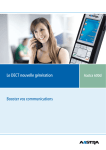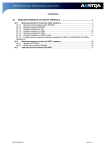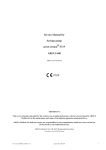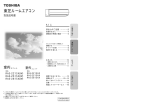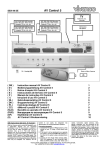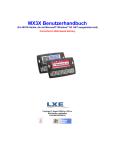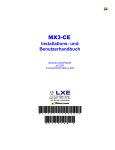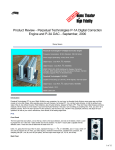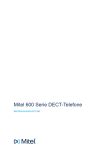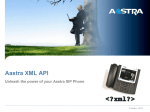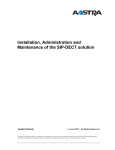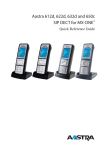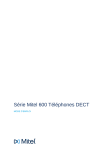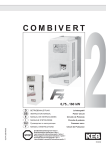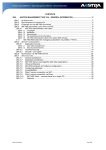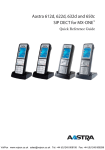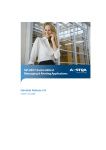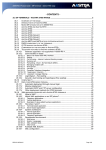Download - CONTENTS - 47. AASTRA DECT TERMINALS
Transcript
A5000 R5.4 Product Guide – DECT Terminals
- CONTENTS 47.
AASTRA DECT TERMINALS ...................................................................................................... 2
47.1
INTRODUCTION ........................................................................................................................ 2
47.2
AASTRA 612D, 622D, 632D AND 650C ...................................................................................... 4
47.2.1 Overview of the range ........................................................................................................ 6
47.2.2 New features brought in by OMM 4.0, and new firmware FP5.0 ....................................... 9
47.2.3 Characteristics of Aastra 612d......................................................................................... 11
47.2.4 Characteristics of Aastra 622d......................................................................................... 13
47.2.5 Characteristics of Aastra 650c ......................................................................................... 16
47.2.6 Characteristics of Aastra 632d......................................................................................... 19
47.2.7 Emergency calls............................................................................................................... 22
47.2.8 Alert messages with AS7900 ........................................................................................... 26
47.2.9 Telephone features .......................................................................................................... 28
47.2.10
Compatibilities .............................................................................................................. 30
47.3
AASTRA 142D ........................................................................................................................ 31
47.3.1 Terminal characteristics ................................................................................................... 31
47.3.2 Alarm function with AS7900............................................................................................. 33
47.3.3 Summary of A142d characteristics .................................................................................. 34
47.3.4 Telephony features of A142d........................................................................................... 35
47.3.5 Compatibilities.................................................................................................................. 36
47.4
SERVICES OFFERED TO DECT TERMINALS .............................................................................. 37
47.4.1 Telephone features .......................................................................................................... 37
47.4.2 Features associated with cordless terminals ................................................................... 37
47.4.3 Computer Telephony Integration (CTI) ............................................................................ 38
47.5
COMPARISON OF THE MAIN SERVICES OFFERED BY THE DECT TERMINALS ............................... 39
47.5.1 DECT terminals with SIP-DECT® / OMM 4.0.................................................................. 39
47.5.2 DECT terminals with IP-DECT / OMM 2.1 ....................................................................... 40
47.5.3 DECT terminals with TDM DECT .................................................................................... 41
47.6
HEADSETS............................................................................................................................. 41
BPS0121AENAA01
Page 1/41
A5000 R5.4 Product Guide – DECT Terminals
47.
AASTRA DECT TERMINALS
47.1 Introduction
Aastra provides a range of IP/SIP-technology-based DECT mobility solutions.
DECT radio base stations or radio fixed parts (RFPs) are directly connected to the IP network and,
thus, benefit from the flexibility brought in by the IP network. The radio fixed parts use the advantages
offered by the mature and proven DECT technology in the field of corporate telephony mobility for the
radio transmission part.
This offer is based on the latest Aastra technology: the SIP convergence protocol.
For more information about the IP DECT infrastructure offer, see the chapter "SIP DECT mobility
services" in the Product Guide.
Moreover, Aastra proposes an integrated TDM DECT-based mobility solution. TDM DECT RFPs
connect to Aastra X Series Gateways via some specific devices.
For more information about the integrated Aastra TDM DECT infrastructure offer, see the chapter
"DECT mobility services" in the Product Guide.
For these two SIP-DECT and TDM-DECT offers, Aastra is developing and marketing a full range of
professional DECT terminals.
In accordance with the GAP standard, these terminals can equally be declared on installations of other
manufacturers which comply with this standard.
BPS0121AENAA01
Page 2/41
A5000 R5.4 Product Guide – DECT Terminals
Integrated
TDM
DECT
compatibility
IP
DECT
compatibility
Strong points
Aastra
612d,
622d, 632d and
A650c:
A new range of
TDM DECT and
IP / SIP DECT®
compatible
Aastra terminals
Yes
As of Aastra
5000 R5.2
Yes
With OMM 2.1,
as of Aastra
5000 R5.2
With OMM 4.0,
as of Aastra
5000 R5.4 SP1
Generalised colour screen
Full duplex hands-free function
Headset socket
Directory with 200 contacts
Call logs
Vibration (buzzer) (except 612d)
Programmable audio profiles
Bluetooth interface (except 612d)
Program keys
SD card (except 612d)
A632d: DATI & SOS button, as
well as loss of verticality function
A650c: high-quality audio (CAT-iq
1.0)
Aastra
610d,
620d and 630d:
Old range of
TDM DECT and
IP / SIP DECT®
compatible
Aastra terminals
Yes
From
Aastra
5000
R5.1B
phase 2
Yes
With OMM 2.1,
as of Aastra
5000 R5.2
With OMM 4.0,
as of Aastra
5000 R5.4 SP1
Full duplex hands-free function
Headset socket
Directory with 200 contacts
Call logs
Vibration (buzzer) (except 610d)
Programmable audio profiles
Bluetooth interface (except 610d)
Program keys
SD card (except 610d, only as of
OMM 4.0)
A630d: DATI & SOS button, as
well as loss of verticality function
Aastra 142d:
TDM-DECT and
IP / SIP-DECT®
compatible
DECT terminal.
Yes
As of Aastra
5000 R5.1
Yes
With OMM 2.1,
as of Aastra
5000 R5.2
With OMM 4.0,
as of Aastra
5000 R5.4 SP1
Black and white screen
Backlit screen and keypad
Hands-free
Headset socket
Vibration (buzzer)
SOS key
MEM card
The new range of DECT terminals, Aastra 6x2d (612d/622d/632d) and Aastra 142d, are described in
this chapter.
The old range of DECT terminals, Aastra 6x0d (610d/620d/630d), are described in the chapter
Release R5.3.
BPS0121AENAA01
Page 3/41
A5000 R5.4 Product Guide – DECT Terminals
47.2 Aastra 612d, 622d, 632d and 650c
The current range of DECT/GAP/CAP-standard DECT terminals, Aastra 6x0d, is gradually being
replaced with a new range, Aastra 6x2d, and enhanced with a fourth DECT terminal:
•
•
•
•
Entry level terminal range A610d A612d
Mid-range terminal A610d A612d
Top-of-the-range DATI (Isolated Worker Protection Management) terminal A630d A632d
New Aastra IP/SIP DECT terminal 650c, based on the CAT-iq 1.0 standard (HQ audio)
The present R5.4 product guide describes the new range of DECT terminals - Aastra 6x2d.
For more information about the old range of DECT terminals, Aastra 6x0d, please see the product
guide of the previous releases.
Differences between Aastra DECT terminals 6x0d and 6x2d
Aastra 6x2d-series terminals (612d, 622d, 632d) have the same design as the old 6x0d-series
terminals (610d, 620d, 630d). However, 6x2d-series terminals use a more modern technology, have
quicker data access and a larger memory for future applications; moreover, they all have a colour
screen.
BPS0121AENAA01
Page 4/41
A5000 R5.4 Product Guide – DECT Terminals
New features in A6x2d-series terminals:
•
Aastra 612d:
•
Backlit colour screen
•
More powerful processor and RAM
•
New software 5.0, which brings in new ergonomics
•
Aastra 622d:
•
More powerful processor and RAM
•
New software 5.0, which brings in new ergonomics
•
Aastra 632d:
•
Double-injection plastic front/back housing for more solidity
•
More powerful processor and RAM
•
New software 5.0, which brings in new ergonomics
Characteristics of Aastra DECT terminal 650c:
•
•
•
•
•
IP/SIP DECT terminal based on CAT-iq 1.0
standard
For users with high expectations
Broadband audio quality (equivalent of G.722) thanks to its advanced components
(loudspeaker, microphone, processor)
The same functional level as terminal A620d
Specific accessories (belt clip, protective cover)
In accordance with the GAP standard, all these terminals can equally be declared on installations of
other manufacturers which comply with this standard.
BPS0121AENAA01
Page 5/41
A5000 R5.4 Product Guide – DECT Terminals
These DECT terminals have been designed to meet the needs of corporate users, thanks to their
ergonomics, which makes them user friendly, or even their wide screen.
Moreover, the DECT terminals allow the reception of alarm messages sent by alarm server AS7900.
They are mainly characterised by a modern and innovative design, similar to that of GSM handsets.
Aastra 6x2d and 650c are both TDM-DECT and IP/SIP-DECT compatible. For more information,
see the section "Compatibilities".
47.2.1 Overview of the range
The main characteristics of these terminals are:
•
•
•
•
The have a colour screen.
They have the same design.
They share a common software solution.
They have the same functions.
A modern, user-friendly design to enhance mobility:
•
A variety of colours and screen backgrounds is available, to personalise the terminals.
•
Pop-up messages indicate to the user, for example, that there is an incoming unanswered
call.
•
A scroll bar indicates to the user his or her location while accessing information on his or her
handset.
•
Some graphic items simplify information-reading on and the use of the terminal.
•
Keys on the side of the terminal enable the user to easily manage the listening volume and
create personalised shortcuts (for instance, voicemail accesses).
BPS0121AENAA01
Page 6/41
A5000 R5.4 Product Guide – DECT Terminals
•
These terminals are similar in their design and use (central navigation keypad) of GSM type
features.
•
Moreover, a Bluetooth interface, available on A620d/A622d and A630d/632d and A650c
series terminals, allows easy connection of a Bluetooth headset. It is also possible to take an
incoming call via the Bluetooth headset. If the terminal ringer is deactivated, some beeps or a
ring tone may be played back in the headset to indicate an incoming call.
GN Netcom M5390, BT530, and GO 6430 type headsets have been validated for Aastra 5000
<= R5.3 and are currently being validated for Aastra R5.4 SP1.
•
•
Automatic noise detection: during connections in a noisy environment. The handset tries to
improve voice transmission if this option is activated.
BPS0121AENAA01
Page 7/41
A5000 R5.4 Product Guide – DECT Terminals
Common software solution:
•
•
•
•
DECT / GAP standards compatible
Software loading over the Air (only in an IP-DECT environment as of OMM 2.1 for A6x0d
series terminals, and in an SIP-DECT® OMM 4.0 environment for terminals A6x2d and
A650c)
Or software loading via PC on the terminal USB port (except A612d)
Possibility to consult the LDAP directory of the Aastra 5000 solution for the call by name
function in an IP DECT / SIP DECT® environment.
BPS0121AENAA01
Page 8/41
A5000 R5.4 Product Guide – DECT Terminals
47.2.2 New features brought in by OMM 4.0, and new firmware FP5.0
The new features brought in by OMM 4.0 (as of Aastra 5000 R5.4 SP1), with the new firmware FP5.0
on this DECT terminal range are:
Better ergonomics:
It is more user-friendly thanks to the use of checkboxes to indicate the activation or deactivation of
functions, as shown below:
This new design is available as of firmware 5.0 on:
•
•
•
Aastra DECT terminals 6x2d
Aastra DECT terminals 650c
Aastra DECT terminals 6x0d
Other changes:
•
•
•
•
•
•
•
Interface between Aastra 5000 and SIP-DECT® 4.0 which works with SIP standard.
OM AXI Web Services interface for SIP-DECT® subscriber management by Aastra 5000 (via
AMP)
HQ audio CAT-iq and G.722 compatible
Three-party conference function integrated into OMM 4.0 (in the RFPs)
Free Seating between DECT terminals
New G.729 licence
OMP (OpenMobility Management Portal) software upgrade
For more information about the functions supported with FP5.0, see Chapter 10, "DECT Features" tab.
Aastra SD micro card compatibility:
•
•
•
•
On new-generation DECT terminals A622d, A632d and A650c
On old-generation DECT terminals A620d, A630d (with some limitations as to the type of data
stored)
Compatibility with this micro SD card facilitates maintenance: it stores terminal registration
data, the device's most important internal data, as well as the private phone directory.
Security is reinforced: the data on the card is encrypted, and only the Aastra SD card can be
used.
BPS0121AENAA01
Page 9/41
A5000 R5.4 Product Guide – DECT Terminals
Once the terminal is working with an Aastra SD micro card, the following terminal settings are stored
on the card then used from the card:
•
•
•
•
•
•
•
•
System -> Subscription / IPEI / Auto search
Settings -> Display (except "Brightness")
Settings -> Brightness (except "LED" indications)
Settings -> Device options
Time / Alarm -> Format settings
Audio (except "noise detection", "Noisy environment", "Volume" / "Tones" for messages)
Personal directory, VIP list
Programmed keys
If the terminal is already registered, the device IPEI will be exchanged with that of the card. This
enables the device to work even if the card is later removed, and helps avoid problems of copied and
duplicated IPEIs.
BPS0121AENAA01
Page 10/41
A5000 R5.4 Product Guide – DECT Terminals
47.2.3 Characteristics of Aastra 612d
Aastra 612d:
Note: in the text below, the new features brought in by A612d, compared to A610d, are indicated in
red.
Characteristics:
Screen, keypad
• A612d: backlit colour TFT screen (2", 176×220 pixels, 65 536 colours), 6 lines plus 2 lines: one
title line and one line for displaying the pop-up menus of virtual keys
• Backlit keypad
• Three interactive virtual keys, two of which can also be used as programmable keys to access
some functions such as: access to a list of numbers (VIP list), access to alarm programming
mode, appointment, profile selection, call logs, voicemail box, private directory, SOS call
• One LED with three different colours (red, green and orange) on top of the terminal, for letting
the user know some statuses or events such as unanswered calls, the availability of a
message in the voicemail box, active hands-free mode, etc.
• Manual or automatic keypad lock
• Contrast management (7 levels)
• Possibility to choose the name to be displayed on the terminal’s idle screen
• 9 speed-dial keys
• Symbols indicating the battery charging level, signal level, ringer, hands-free mode, and the
availability of a message in the voicemail box.
• A VIP directory can also be assigned to the programmable keys of Aastra 612d (left and
intermediate display keys located under the screen and the left and right navigation keys). A
VIP list contains a maximum of six phone numbers to which a specific ring tone can be
assigned.
BPS0121AENAA01
Page 11/41
A5000 R5.4 Product Guide – DECT Terminals
Audio
• DECT XQ compatible (as of OMM 2.1- IP-DECT and as of OMM 4.0 - SIP DECT) to offer the
best voice quality in highly reflecting environments (reinforced glass, metal structures and
walls). Thanks to this Aastra proprietary technology, radio reflections are highly reduced and
audio quality is less subject to potential cracking sounds in the above-mentioned environments.
• 44 polyphonic ring tones
• Different ring tones, for instance, for incoming internal or external calls, messages (AS7900) or
alarms, or emergency calls (location server)
• Full duplex hands-free function
• Automatic noise detection to adapt to the user's environment and automatically change the
ringer volume - managing noisy environments
• Ringer off
• Ringer volume adjustment (9 levels)
• Two keys on the side of the terminal for volume management
• Different volume adjustment for loudspeaker, headset and terminal.
Interfaces
• Headset socket
Local functions
• Personal directory for 200 contacts with privilege ring tones
• Internal incoming call / redial log: 30 entries / 20 entries
• Centralised A5000 caller / redial log: 30 entries / 30 entries (50 entries / 30 entries if OMM is
hosted by a server)
• Management of five different programmable profiles by the user, for example “at a meeting”, “in
the office”; the current profile is displayed on the idle screen.
• 16 languages available: British English, French, German, Flemish, Spanish, Italian, Dutch,
Norwegian, Swedish, Portuguese, Danish, Finnish, Czech, Slovak, Polish, and Russian.
• Management of appointment calendar
Others
• Beep indicating that the battery is empty or that the terminal is outside the radio coverage area
• Automatic off-hook when the terminal is removed from the charger
• Silent charging: the terminal does not ring while charging.
Technical data:
•
•
•
•
•
•
•
Standards: DECT, GAP
IP 50 compatibility - protection against dust deposit
Dimensions: 135 x 49 x 22.5 mm
Weight including batteries: 127 g
Software update via the air interface (as of OMM 4.0)
Battery duration: 100h in standby mode, 12h in communication mode
850mAh Lithium-Ion battery
BPS0121AENAA01
Page 12/41
A5000 R5.4 Product Guide – DECT Terminals
47.2.4 Characteristics of Aastra 622d
Main features (in bold the new features compared to Aastra 612d):
Screen, keypad
• Backlit colour TFT screen (2", 176 x 220 pixels, 65536 colours) with possibility to set the
backlighting time
• Screen with 7 lines plus two extra lines: one title line and one line for displaying virtual key popup menus, backlighting time adjustment
• Backlit keypad
• Three interactive virtual keys, two of which can also be used as programmable keys to access
some functions such as: access to a list of numbers (VIP list), access to alarm programming
mode, appointment, profile selection, call logs, voicemail box, private directory, SOS call
• One LED allowing three different colours (red, green and orange) on top of the terminal, for
letting the user know some statuses or events such as unanswered calls, the availability of a
message in the voicemail box, active hands-free mode, etc.
• Manual or automatic keypad lock
• Contrast management (7 levels)
• Possibility to choose the name to be displayed on the terminal’s idle screen
• Screen personalisation with a set of colours – different themes and screen background
images
• 9 speed-dial keys
• Symbols indicating the battery charging level, signal level, ringer, hands-free mode, mute,
alarm activation, availability of a message in the voicemail box.
• Three keys on the side of the terminal for volume management or to be used as shortcut
to a function (programmable by the user)
• 1 hotkey for generating an emergency call.
• The special key (speed-dial key) located on the upper right side of Aastra 622d is meant, with
the factory settings (though it can be reprogrammed), for recording in form of a directory or
BPS0121AENAA01
Page 13/41
A5000 R5.4 Product Guide – DECT Terminals
VIP list of six phone numbers maximum, with particularly speedy access and the possibility to
assign a specific ring tone to all the VIP numbers.
Audio
• DECT XQ compatible (as of OMM 2.1- IP-DECT) to offer the best voice quality in highly
reflecting environments (reinforced glass, metal structures and walls). Thanks to this Aastra
proprietary technology, radio reflections are highly reduced and audio quality is less subject to
potential cracking sounds in the above-mentioned environments.
• 44 polyphonic ring tones
• Different ring tones, for instance, for incoming internal or external calls, messages (AS 7900) or
alarms, or emergency calls (location server)
• Full duplex hands-free function
• Automatic noise detection to adapt to the user's environment and automatically change the
ringer volume - managing noisy environments
• Ringer off
• Ringer volume adjustment (9 levels)
• Three keys on the side of the terminal for volume management
• Different volume adjustment for loudspeaker, headset and terminal
• Management of different audio profiles which can be selected by the user
Interfaces
• Headset socket
• Vibration (buzzer)
• USB interface
• Bluetooth interface (with the possibility to connect a Bluetooth headset)
• MicroSD card interface (SD card provided separately)
Local functions
• Private directory for 200 contacts (3 numbers per contact) with privilege ring tones (different
ring tone for certain calls)
• Internal caller / redial log: 50 entries / 30 entries
• Centralised A5000 caller / redial log: 30 entries / 30 entries (50 entries / 30 entries if OMM is
hosted by a server)
• Management of five different programmable profiles by the user, for example “at a meeting” “in
the office”; the current profile is displayed on the idle screen.
• 16 languages available: British English, French, German, Flemish, Spanish, Italian, Dutch,
Norwegian, Swedish, Portuguese, Danish, Finnish, Czech, Slovak, Polish, and Russian.
• Appointment management
• Vibration (buzzer)
Others
• Beep indicating that the battery is empty or that the terminal is outside the radio coverage area
• Automatic off-hook when the terminal is removed from the charger
• Silent charging: the terminal does not ring while charging.
BPS0121AENAA01
Page 14/41
A5000 R5.4 Product Guide – DECT Terminals
Technical data:
•
•
•
•
•
•
•
•
Standards: DECT, GAP
IP 50 compatibility – protection against dust deposit
Dimensions: 135 x 49 x 22.5 mm
Weight including batteries: 127 g
Software update via the air interface (as of OMM 4.0) or PC via mini-USB port
Battery duration: 100h in standby mode, 12h in communication mode
850mAh Lithium-Ion battery
Optional: battery with a higher capacity (200h in standby mode, 24h in conversation mode)
1800mAh
• Mini-USB socket for charging the terminal via a PC
BPS0121AENAA01
Page 15/41
A5000 R5.4 Product Guide – DECT Terminals
47.2.5 Characteristics of Aastra 650c
This new terminal A650c is ideal for users with high expectations.
Aastra 650c is a DECT terminal, compatible with the new CAT-iq 1.0 ("Cordless Advanced
Technology – internet and quality") DECT standard, which allows high-quality, broadband telephony
(compatible with Aastra Hi-Q audio technology).
To have this high call quality, the DECT terminal, SIP-DECT® RFPs, as well as the correspondent's
terminal, must support G.722.
The new standard is supported by Aastra SIP-DECT® systems as of OMM 4.0 (R5.4 SP1 minimum),
with a uniform DECT network made up of new-generation RFP 35 IP, RFP 36 IP, RFP 37 IP, or RFP
43WLAN.
Aastra 650c has the same software as A6x2d-series terminals.
It has the same functions as Aastra 622d, but it is bigger by 1 cm. As a result of this, it has specific
accessories, a rotating clip, protective cover, and battery cover.
Concerning the Aastra microSD card, it is possible to manage all the 650c settings to be transferred to
the card, except the Bluetooth settings and screen brightness.
BPS0121AENAA01
Page 16/41
A5000 R5.4 Product Guide – DECT Terminals
Main features (in bold the new features compared to Aastra 622d):
Screen, keypad
• Backlit colour TFT screen (2", 176 x 220 pixels, 65536 colours) with possibility to set the
backlighting time
• Screen with 7 lines plus two extra lines: one title line and one line for displaying virtual key popup menus, backlighting time adjustment
• Backlit keypad
• Three interactive virtual keys, two of which can also be used as programmable keys to access
some functions such as: access to a list of numbers (VIP list), access to alarm programming
mode, appointment, profile selection, call logs, voicemail box, private directory, SOS call
• One LED allowing three different colours (red, green and orange) on top of the terminal, for
letting the user know some statuses or events such as unanswered calls, the availability of a
message in the voicemail box, active hands-free mode, etc.
• Manual or automatic keypad lock
• Contrast management (7 levels)
• Possibility to choose the name to be displayed on the terminal’s idle screen
• Screen personalisation with a set of colours – different themes and screen background
images
• 9 speed-dial keys
• Symbols indicating the battery charging level, signal level, ringer, hands-free mode, mute,
alarm activation, availability of a message in the voicemail box.
• Three keys on the side of the terminal for volume management or to be used as shortcut
to a function (programmable by the user)
• 1 hotkey for generating an emergency call.
• The special key (speed-dial key) located on the upper right side of the terminals is meant, with
the factory settings (though it can be reprogrammed), to save in form of a directory or VIP list
of six phone numbers maximum, with particularly speedy access and the possibility to assign a
specific ring tone to all the VIP numbers.
Audio
• CAT-iq 1.0 compatibility: offers a high audio quality for calls between equivalent DECT
terminals or with a compatible wired terminal (G.722)
• DECT XQ compatible (as of OMM 2.1- IP-DECT) to offer the best voice quality in highly
reflecting environments (reinforced glass, metal structures and walls). Thanks to this Aastra
proprietary technology, radio reflections are highly reduced and audio quality is less subject to
potential cracking sounds in the above-mentioned environments.
• 44 polyphonic ring tones
• Different ring tones, for instance, for incoming internal or external calls, messages (AS 7900) or
alarms, or emergency calls (location server)
• Full duplex hands-free function
• Automatic noise detection to adapt to the user's environment and automatically change the
ringer volume - managing noisy environments
• Ringer off
• Ringer volume adjustment (9 levels)
• Three keys on the side of the terminal for volume management
• Different volume adjustment for loudspeaker, headset and terminal.
• Management of different audio profiles which can be selected by the user
BPS0121AENAA01
Page 17/41
A5000 R5.4 Product Guide – DECT Terminals
Interfaces
• Headset socket
• Vibration (buzzer)
• Bluetooth interface (with the possibility to connect a Bluetooth headset)
• MicroSD card interface (SD card provided separately)
Local functions
• Private directory for 200 contacts (3 numbers per contact) with privilege ring tones (different
ring tone for certain calls)
• Internal caller / redial log: 50 entries / 30 entries
• Centralised A5000 caller / redial log: 30 entries / 30 entries (50 entries / 30 entries if OMM is
hosted by a server)
• Management of five different programmable profiles by the user, for example “at a meeting” “in
the office”; the current profile is displayed on the idle screen.
• 16 languages available: British English, French, German, Flemish, Spanish, Italian, Dutch,
Norwegian, Swedish, Portuguese, Danish, Finnish, Czech, Slovak, Polish, and Russian.
• Appointment management
• Vibration (buzzer)
Others
• Beep indicating that the battery is empty or that the terminal is outside the radio coverage area
• Automatic off-hook when the terminal is removed from the charger
• Silent charging: the terminal does not ring while charging.
Technical data:
• Standards: DECT, GAP
• IP 50 compatibility – protection against dust deposit
• Compatible with broadband CAT-iq 1.0. Note: the
icon is only visible on screen when the call
is in broadband audio.
• Dimensions: 145 x 49 x 22.5 mm
• Weight including batteries: 130 g
• Software update via the air interface (as of OMM 4.0) or PC via mini-USB port
• Battery duration: 100h in standby mode, 12h in communication mode
• 850mAh Lithium-Ion battery
• Optional: battery with a higher capacity (200h in standby mode, 24h in conversation mode)
1800mAh
• Mini-USB socket for charging the terminal via a PC
BPS0121AENAA01
Page 18/41
A5000 R5.4 Product Guide – DECT Terminals
47.2.6 Characteristics of Aastra 632d
Note: in the text below, the new features brought in by A632d, compared to A630d, are indicated in
red.
Main features (in bold the new features compared to Aastra 622d):
Screen, keypad
• Backlit colour TFT screen (2", 176 x 220 pixels, 65536 colours) with possibility to set the
backlighting time
• Screen with 7 lines plus two extra lines: one title line and one line for displaying virtual key popup menus, backlighting time adjustment
• Backlit keypad
• Three interactive virtual keys used as programmable keys to access some functions such as:
access to a list of numbers (VIP list), access to alarm programming mode, appointment, profile
selection, call logs, voicemail box, private directory, SOS call
• One LED allowing three different colours (red, green and orange) on top of the terminal, for
letting the user know some statuses or events such as unanswered calls, the availability of a
message in the voicemail box, active hands-free mode, etc.
• Manual or automatic keypad lock
• Contrast management (7 levels)
• Possibility to choose the name to be displayed on the terminal’s idle screen
• Screen personalisation with a set of colours – different themes and screen background images
• 9 speed-dial keys
• Symbols indicating the battery charging level, signal level, ringer, hands-free mode, mute,
alarm activation, availability of a message in the voicemail box.
• Three keys on the side of the terminal for volume management or to be used as shortcut
to a function (programmable by the user)
• 1 hotkey for generating an emergency call.
• One SOS key on top of the terminal
BPS0121AENAA01
Page 19/41
A5000 R5.4 Product Guide – DECT Terminals
• Position alarm detector, no-movement alarm, evacuation alarm (no-movement alarm and
evacuation alarm are available only with R5.1C and version 2.03 of the terminal).
• Withstands a two metre fall.
• The special key (speed-dial key) located on the upper right side of Aastra 62xd is meant, with
the factory settings (though it can be reprogrammed), for recording in form of a directory or
VIP list of six phone numbers maximum, with particularly speedy access and the possibility to
assign a specific ring tone to all the VIP numbers. Function available only as from R5.1C and
version 2.03 of terminal A630d.
Audio
• DECT XQ compatible (as of OMM 2.1- IP-DECT) to offer the best voice quality in highly
reflecting environments (reinforced glass, metal structures and walls). Thanks to this Aastra
proprietary technology, radio reflections are highly reduced and audio quality is less subject to
potential cracking sounds in the above-mentioned environments.
• 44 polyphonic ring tones
• Different ring tones, for instance, for incoming internal or external calls, messages (AS 7900) or
while making an emergency call (on the terminal making the emergency call) (location
server)
• Full duplex hands-free function
• Automatic noise detection to adapt to the user's environment and automatically change the
ringer volume - managing noisy environments
• Ringer off
• Ringer volume adjustment (9 levels) – possibility to have a very high ringer volume
• Three keys on the side of the terminal for volume management
• Different volume adjustment for loudspeaker, headset and terminal.
• Management of different audio profiles which can be selected by the user
Interfaces
• Headset socket
• Vibration (buzzer)
• Bluetooth interface (with the possibility to connect a Bluetooth headset)
• MicroSD card interface (SD card provided separately)
Local functions
• Private directory for 200 contacts (3 numbers per contact) with privilege ring tones (different
ring tone for certain calls)
• Internal caller / redial log: 50 entries / 30 entries
• Centralised A5000 caller / redial log: 30 entries / 30 entries (50 entries / 30 entries if OMM is
hosted by a server)
• Management of five different programmable profiles by the user, for example “at a meeting” “in
the office”; the current profile is displayed on the idle screen.
• 16 languages available: British English, French, German, Flemish, Spanish, Italian, Dutch,
Norwegian, Swedish, Portuguese, Danish, Finnish, Czech, Slovak, Polish, and Russian.
• Appointment management
• Vibration (buzzer)
BPS0121AENAA01
Page 20/41
A5000 R5.4 Product Guide – DECT Terminals
Others
• Beep indicating that the battery is empty or that the terminal is outside the radio coverage area
• Automatic off-hook when the terminal is removed from the charger
• Silent charging: the terminal does not ring while charging.
Special features of A632d
• Isolated Worker Protection Management: Loss of verticality detector, no-movement alarm,
evacuation alarm
• Dedicated SOS key for emergency call
• The keypad can be washed with water for use in a hospital environment for instance (do
not use abrasive or corrosive products).
• 9 volume levels for the ringer and 1 very high level.
• Moreover, A632d has a front/back double-injection plastic cover, which makes it more shockresistant.
Technical data:
•
•
•
•
•
•
•
•
Standards: DECT, GAP
IP 65 compatible - protection against dust and water splash
Dimensions: 135 x 53 x 22.5 mm
Weight including batteries: 139g
Software update via the air interface (as of OMM 4.0) or PC via mini-USB port
Battery duration: 100h in standby mode, 12h in communication mode
850mAh Lithium-Ion battery
Optional: battery with a higher capacity (200h in standby mode, 24h in conversation mode)
1800mAh
• Mini-USB socket for charging the terminal via a PC
Using A632d in very cold environments:
Aastra 632d has been designed for use on the following conditions:
• Terminal:
−
Working temperature between 5°C and 40°C
−
Storage temperature between -5°C and 45°C
−
IP protection class 65 (protection against dust and water projection)
• Battery:
−
Working temperature between 0°C and 50°C
−
Storage temperature between -20°C and 50°C
In practice, this means that the terminal should not be used directly in environments in which the
temperature is below 5°C, for long-term operations (for instance, in cold rooms).
To protect the terminal against cold, the user must carry it on his clothes (the terminal can also be put
in a leather protective cover). The use of a wired or Bluetooth headset (authorised for very cold
temperatures) is then recommended, to keep the terminal warm.
Some tests in very cold conditions show that the terminal may work after staying for several hours in
the cold, but the components suffer from being used outside their specifications and may be damaged
(cracks).
In particular, the battery is highly used up by cycles in warm and cold environments. Moreover, using it
in cold environments reduces the service life and capacity of the battery.
Due to the technical specifications, Aastra does not guarantee terminals used outside the normal
temperatures specified above.
Warning: failing to use the terminals according to the specifications may damage the terminal and be
hazardous to the health.
BPS0121AENAA01
Page 21/41
A5000 R5.4 Product Guide – DECT Terminals
Caution: if a terminal reaches a temperature below +10°C, it should not be charged at this temperature
as this may result in malfunctions.
47.2.7 Emergency calls
It is possible to define an SOS number or a phone number to be dialled for an emergency call.
This emergency number is dialled when:
• the dedicated SOS key, located on top of Aastra 632d, is pressed (pressing and holding down
the SOS key sends the alarm immediately without the user's confirmation; pressing the key
briefly sends the alarm after the user's confirmation).
• an SOS call button programmed on Aastra 612d, 622d, 650c or 632d is pressed (possible to
press the key briefly only; pressing and holding down the programmed key activates the
programming function)
• or the loss of verticality, no-movement (dead man) or evacuation alarms, available with Aastra
632d, are triggered
For more information, please see the following chapters in the product guide:
•
"Mobility Services - SIP-DECT® offer - OMM 4.0"
•
“Broadcasting alarm messages on DECT handsets - Alarm server AS7900 R3.2”.
BPS0121AENAA01
Page 22/41
A5000 R5.4 Product Guide – DECT Terminals
A632d-specific emergency call functions
A632d is a DECT terminal suited to industrial or hospital environments, thanks to the following
features:
Dedicated SOS key:
A632d has a specific SOS key. When this key is pressed, the terminal changes to hands-free mode
and dials automatically the previously saved emergency number.
Note: no feature code is available on the terminal during an SOS call.
The user (in TDM DECT) or administrator (in IP DECT / SIP-DECT®) can define an emergency
number called by simply pressing the SOS key. This emergency number is the same as the phone
number dialled while seeking to detect the loss of verticality.
It is possible to define the time that must pass before an emergency call is actually made. Within this
interval, a rising tone (a SOS beep) is activated on the handset (if enabled) to locate the person in
need of help. It is still possible to switch off the alarm while this pre-alarm is active.
The terminal changes automatically to hands-free mode.
Note: a wired digital or IP/SIP terminal (such as Aastra 5300ip or Aastra 6700i) with a dedicated
number is required to receive SOS calls.
If nobody has been able to answer the emergency call (for example, because the called party is
“busy”), it is possible to define the timeout for reactivating the pre-alarm before making the emergency
call again.
Note: in TDM DECT, this function is only available if the terminal is idle and in SIP-DECT® if the
handset is idle or used for a simple call.
Moreover, an emergency call can be made by pressing a programmed emergency call key
(programmable key or lateral key) on A632d.
Alarm sensor (Aastra 632d only)
Aastra 632d is fitted with an alarm sensor which always determines the inclination angle and
movement of the device. It is possible to deduce from it different alarm types that trigger an alarm call
automatically. This requires an alarm number or emergency/SOS call number (see previous column)
to be programmed, and the alarm detector function activated.
The following alarms are taken into account:
• Loss of verticality (or dead man) alarm
• No movement (or immobility) alarm
• Evacuation (or escape or anti-snatch alarm)
Aastra recommends configuring only one alarm on the DECT terminal - the one most suited to the
user's situation.
The alarm number is the same for the three alarm types. If no alarm number has been saved, the
emergency call number stored on the emergency / SOS call number key is used.
It is always the first alarm type identified that is signalled. Activated alarm detectors are displayed with
the symbol
on the first line of the screen.
To know the active alarm, see among others the "Active functions" menu.
BPS0121AENAA01
Page 23/41
A5000 R5.4 Product Guide – DECT Terminals
Position alarm or detection of loss of verticality
When the “Position detector” function is activated, a mercury-based integrated position detector
continuously determines the terminal inclination angle. Normally, the terminal is carried in an almost
vertical position, for instance, when fixed on the user's belt clip. The position of the terminal is
measured every 5 seconds. The system then checks whether the telephone is still in vertical position.
If the terminal inclination angle differs by more than X degrees from the upright position, the alarm is
triggered at the end of a configurable timeout as there may be an emergency.
Thanks to a setting in the menu, a call from an emergency number programmed on the terminal can
be taken automatically in hands-free mode.
The position detector can only be activated when the terminal is:
• Idle - in a TDM DECT environment
• Idle or used for a simple call only - in an IP DECT / SIP DECT environment.
Changes with firmware FP5.0 of the terminals and OMM 4.0:
• The inclination angle, compared to the vertical angle, can now be configured with three values:
high (approx. 45°), average (approx 35°) and flat ( approx 25°)
• Alarm transmission may be deactivated when:
•
•
−
The user is engaged in a call
−
The user is navigating through the terminal menus
Pre-alarm can also be indicated by a vibration (in addition to a ring tone).
The configurable timeout before pre-alarm is extended to 75 seconds.
No-movement alarm
This alarm is set off after a certain period of immobility (no movement on the part of the user holding
the terminal). The detector's sensitiveness may be set to three levels. It is advisable to test the
sensitiveness of the immobility alarm with the person to be monitored, in order to guarantee hitch-free
operation.
This alarm is inhibited when the terminal is left to charge on its desktop charger or via a USB cable.
This alarm may be very useful for detecting a surveillance patrol interruption in a building such as a
prison, or for security staffs.
Evacuation or escape alarm
The evacuation alarm is set off if the sensor detects intense movements of the terminal after an
adjustable lapse of time. Like for the “no-movement” alarm, the sensitiveness of the detector can be
set to three levels. It is advisable to test the sensitiveness of the evacuation alarm with the person to
be monitored, in order to guarantee hitch-free operation.
This alarm may be very useful for detecting an attack or theft of the terminal, for instance.
BPS0121AENAA01
Page 24/41
A5000 R5.4 Product Guide – DECT Terminals
Alarm duration parameters
The alarm durations are defined as follows:
• Timeout: lapse of time starting after the event that set off the alarm (position, immobility,
escape).
If the event that triggered the alarm is cancelled during this lapse of time for at least 2
seconds, the timeout restarts.
The timeout may be defined separately for each alarm type.
• Pre-alarm duration: this is the lapse of time during which an alarm tone (if activated) is set off
on the terminal before the emergency number is dialled. During the pre-alarm period,
information on the screen indicates the time remaining before the alarm number is dialled.
If the event that set off the alarm is cancelled during this pre-alarm period for at least 4
seconds, in case of position alarm, and at least 2 seconds for a no-movement alarm), the
timeout restarts.
The pre-alarm duration is collectively defined for all types of alarms, and pre-alarm can also be
indicated by a buzz.
Changes with firmware FP5.0 of the terminals and OMM 4.0:
• Pre-alarm can also be indicated by a vibration (in addition to a ring tone).
.
Defining other alarm parameters
• Alarm number: this menu option is not displayed if the emergency/SOS number is indicated
by the system.
• Auto acceptance (alarm): if this function is enabled, every call is automatically taken during
the pre-alarm period. If this function in enabled and there is an incoming call or an already
existing call during the pre-alarm period, the alarm number is dialled at the end of the prealarm period. Regardless of the setting, calls to the alarm number or emergency/SOS number
are automatically taken, and pre-alarm stopped.
• Alarm tone: pre-alarm may be indicated with or without alarm tone on the terminal. If the alarm
tone is activated, signalling is made with a progressive volume.
• Vibration (buzzer): pre-alarm may take place with or without buzzer.
• Repeat alarm: this is the period of time after which a new pre-alarm is set off, followed by
dialling of the alarm number (example when the alarm number has been interrupted by the
system).
• Alarm with handsfree: for determining whether the alarm must be set off in hands-free or
terminal mode. This parameter also applies to the emergency call via the emergency calI/SOS
key.
BPS0121AENAA01
Page 25/41
A5000 R5.4 Product Guide – DECT Terminals
Emergency call function on A612d, A622d and A650c
It is possible to program an emergency call key on DECT terminals A612d, A622d and A650c: on a
programmable key (keys located on the screen) or lateral key (A622d/A650c)
Caution: on 622d/A650c, if any of the lateral keys has been programmed as an SOS key, it can no
longer be used during a call to adjust the volume. In this case, you have to use the navigation keys to
adjust the volume.
47.2.8 Alert messages with AS7900
Aastra 6xxd/c is compatible with the alert messages function.
Note: the alarm function with AS7900 is available, no matter the terminals A6xxd/c:
• In a SIP-DECT® environment: from A5000 R5.4 SP1 and OMM 4.0
• In an IP DECT environment: from A5000 R5.2 SP2 and OMM 2.1
• In a TDM DECT environment: from Aastra 5000 R5.1B
This function is used to receive alarms transmitted by the associated system (alarm server AS 7900),
regardless of whether the handset is idle or in communication mode.
There are two types of alarms:
• Urgent alarms, which can be acknowledged. Acknowledgement enables the system to
record the fact that the alarm has actually been read by the recipient.
• Normal alarms, which cannot be acknowledged. The alarms received (read or unread) are
saved in the alarm log, reserved for alarms only (these alarms are not contained on the caller
list).
Note: urgent alarms are given priority. no action is possible on the terminal until the alarm is
acknowledged. Only line seizure is allowed, to answer a call (or acknowledge the alarm).
Emergency call has priority over alarm acknowledgement.
BPS0121AENAA01
Page 26/41
A5000 R5.4 Product Guide – DECT Terminals
When an alarm arrives (set idle or in communication mode), one of the following screens is displayed:
Alarm management:
An alarm is indicated as follows:
•
•
•
•
On an idle set: a specific ring tone is broadcast.
During a call: a warning tone is broadcast in the earpiece (repeated beeps).
In both cases, the indicator light (LED) flashes red.
The alarm message is displayed on the screen:
−
accompanied by the interactive Acknowledge key for an urgent alarm to be
acknowledged
−
accompanied by the interactive OK key for a normal alarm.
Message log
Received, urgent/non urgent, read/unread messages/alarms are recorded in this log. It can contain up
to 20 messages. When it is full, the oldest message is overwritten by the latest one.
The number of unread messages is displayed as a reminder.
The messages are preceded by a symbol indicating their status:
•
•
•
: Unread non-urgent message
: Unread urgent message
: Read (urgent or non-urgent) message
From the message list, it is possible to display a message, delete a selected message after reading it,
or to empty the log if all the messages have been read.
Quick access to the messages:
You can use any programmable key on the 6xxd handset to quickly access the message log.
For more information about alarm server AS7900, please see the chapter "Broadcasting alarm
messages on DECT terminals - Alarm server AS7900" in the product guide.
BPS0121AENAA01
Page 27/41
A5000 R5.4 Product Guide – DECT Terminals
47.2.9 Telephone features
A6xxd/c gives access to all the functions offered by the Aastra 5000:
•
•
•
•
•
•
•
•
•
•
•
•
•
•
•
•
•
Simple call
Transfer of caller number and name
Transfer
Three-party conference (managed by A5000 if OMM < 4.0 or if controlled by OMM >=4.0) or
(provided by A5000 if OMM < 4.0 and provided by the RFPs if OMM >=4.0)
Immediate forwarding / forwarding on busy, on no answer, internal/external number, follow-me
according to caller number
Hold call
Call pick-up
Automatic callback (via code or via XML interface) (as of OMM 4.0))
Alternate
Do Not Disturb
Redial
Number backup from the incoming call log
Authentication code
Appointment reminder
Parking (via code or via XML interface) (as of OMM 4.0))
Substitution
Etc.
For more information about the list of available features, see Chapter 10 of the product guide: “Table
of compatibilities and capacities” - "Features" tab.
OMM - three-way conference:
As of OMM 4.0, the new RFPs integrate a conference bridge used when the conference-master
terminal is a DECT terminal (A6xxd/c or A142d).
For more information about the management of this function by OMM 4.0, please see the chapter "SIP
DECT mobility services - OMM 4.0" in the product guide.
Features managed by the XML interface - as of OMM 4.0:
An API XML terminal, similar to the one available on Aastra 6700i series SIP terminals, is used to
provide the features offered through code in OMM 2.1 on A6xd terminals as of OMM 4.0.
Features on an idle terminal:
These functions are accessible via "Server Menu":
BPS0121AENAA01
Page 28/41
A5000 R5.4 Product Guide – DECT Terminals
Features on a communicating terminal:
The following functions are available on communicating terminals (as of OMM 4.0), via API XML
terminal:
• Automatic callback
• Parked call
• Malicious call (trace)
The availability of these functions is as follows:
During
call
a
Called
ringing
terminal
Called
busy
terminal
Remote
hooks
terminal
Automatic
callback
-
x
x
-
Parked call
x
-
-
-
Malicious call
x
-
-
x
BPS0121AENAA01
on-
Page 29/41
A5000 R5.4 Product Guide – DECT Terminals
47.2.10 Compatibilities
The A6xxd/c terminal range is available in IP-DECT, SIP-DECT® and TDM DECT
environments:
• In TDM DECT environment as of Aastra 5000 R5.1
• In IP DECT environment as of Aastra 5000 R5.2 SP2 and as of OMM 2.1
• In SIP-DECT® environment as of Aastra 5000 R5.4 SP1 and as of OMM 4.0
The table below summarises the compatibilities between A6xxd/c and the Aastra 5000 /
DECT infrastructure:
A5000
R5.1
A6x0d
Yes
A5000 R5.2
Yes
- TDM DECT - IP DECT: OMM
2.1
- TDM DECT
A6x2d
No
Yes
- IP DECT & OMM
- TDM DECT
A650c
No
Yes
- IP DECT & OMM
- TDM DECT
BPS0121AENAA01
A5000 R5.3
Yes
- IP DECT &
OMM
- TDM DECT
Yes
- IP DECT &
OMM
- TDM DECT
Yes
- IP DECT &
OMM
- TDM DECT
A5000 R5.4
Yes
- IP DECT &
OMM
- TDM DECT
Yes
- IP DECT &
OMM
- TDM DECT
Yes
- IP DECT &
OMM
- TDM DECT
A5000 R5.4 SP1
Yes
- IP DECT & OMM
2.1/4.0
- TDM DECT
Yes
- IP DECT & OMM
2.1/4.0
- TDM DECT
Yes
- IP DECT & OMM
2.1/4.0
- TDM DECT
Page 30/41
A5000 R5.4 Product Guide – DECT Terminals
47.3 Aastra 142d
Aastra 142d is a cordless DECT telephone meant to work on an Aastra communication system.
It has many operating characteristics that make it easy to use, such as the user-friendly command
through interactive keys, the hands-free mode, amplified listening, a buzzer and a luminous graphical
display, as well as call by name in an IP-DECT configuration.
The integrated telephone directory can contain up to 100 alphanumeric records. The use of a headset
is possible and enables users to make phone calls while performing other tasks.
In an Aastra environment, Aastra 142d offers telephone functions such as emergency call functions
via an SOS key.
In a noisy environment, the terminal automatically detects the noise and improves voice transmission.
It is compatible with alarm server AS 7900 for managing alarms in TDM DECT, IP-DECT and SIPDECT® environments.
47.3.1 Terminal characteristics
BPS0121AENAA01
Page 31/41
A5000 R5.4 Product Guide – DECT Terminals
Organisation of the screen:
Memory card:
Aastra 142d is fitted with a memory card, delivered with the device, on which are recorded the
equipment’s local settings (especially the personal directory, the incoming call log, redial log and the
equipment identity (IPEI)). This way, even if you replace the terminal, by using the memory card you
can access this data on another terminal and thus be able to telephone immediately (without
additional recording).
This memory card is not available as a spare part; if this component becomes faulty, it is necessary to
contact Aastra's repair service and to return the entire terminal with its MEM card.
Automatic pick up of receiver
If this function is enabled, communication starts automatically, without pressing the key, in the
following cases:
• When you are using a headset with microphone communication automatically starts after only
one ring tone.
• When the set is being charged, removing the handset from the base station automatically
starts communication.
Silent charging:
If this function is enabled, the telephone will not indicate incoming calls (through ringer or buzzer) as
long as it is charging on its base station. Once the handset is removed from its base station, calls will
start being indicated again.
SOS key: calling an emergency number
Pressing and holding down the
key when the terminal is idle dials the emergency number
defined in the internal menu of A142d (“SOS key” option of the menu).
The handset changes automatically to hands-free / amplified listening mode when the emergency call
is made.
The terminal can make some beeps before setting up the emergency call, so a person in need of help
can be located.
BPS0121AENAA01
Page 32/41
A5000 R5.4 Product Guide – DECT Terminals
47.3.2 Alarm function with AS7900
Aastra 142d is compatible with the alarm function.
This function is used to receive alarms transmitted by the associated system (alarm server AS7900),
regardless of whether the handset is idle or in communication mode.
Alarm management by A142d differs according to IP-DECT context (up to OMM 2.1) or SIP-DECT®
context (as of OMM 4.0).
Managing alarms on A142d - up to OMM 2.1:
The compatible AS7900 release is R3.1.
There are two types of alarms:
• Urgent alarms, which can be acknowledged. Acknowledgement enables the system to
record the fact that the alarm has actually been read by the recipient.
• Normal alarms, which cannot be acknowledged. The alarms received (read or unread) are
saved in the alarm log, reserved for alarms only (these alarms are not contained on the caller
list).
Note: urgent alarms are given priority. The alarms must be processed before any other action on the
handset. Only line seizure is allowed, to answer a call (or acknowledge the alarm).
Pressing the SOS key has priority over alarm acknowledgement.
Alarm management:
An alarm is indicated as follows:
•
•
•
•
On an idle terminal: a specific ring tone is broadcast.
During a call: a warning tone is broadcast in the earpiece (repeated beeps).
In both cases, the info button blinks.
The alarm message is displayed on the screen:
BPS0121AENAA01
−
accompanied by the interactive Ack. key for an urgent alarm to be acknowledged
−
accompanied by the interactive Details key for a normal alarm.
Page 33/41
A5000 R5.4 Product Guide – DECT Terminals
Alarm log
Incoming alarms are recorded in the alarm log.
They are displayed there, preceded by any of the following symbols:
•
: Unread message (urgent alarm or normal alarm)
•
: Read message
: Urgent unacknowledged alarm
•
•
: Urgent unacknowledged but read alarm
The log can contain up to 10 alarms. When it is full, the oldest alarm is overwritten by the latest one.
Managing alarms on A142d - as of OMM 4.0:
The A142d firmware has been upgraded to 91.24.30.7x in order to directly receive alarms from alarm
server AS7900 via OMM 4.0. Therefore, this terminal no longer receives alarms via Aastra 5000, like
in OMM 2.1.
The compatible AS7900 release has been upgraded to R3.2 to manage this change in architecture
with Aastra 142d.
Changes:
• The length of messages is 160 characters maximum (instead of 29 in OMM 2.1).
• 2 ring tones, normal volume and high volume (10 ring tones in OMM 2.1)
• 3 alarm priority levels: info, normal, urgent (10 priority levels in OMM 2.1). The available alarm
priority levels are summarised in the table below:
A142d
OMM 2.1
A142d
OMM 4.0
A6xxd/c
OMM 2.1 & 4.0
Priority 0
Info
Idle
Priority 1
Info
Info
Normal
Low
Priority 2
Normal
Normal
Priority 3
Urgent
High/urgent
Priorities 4 to 9
Urgent
Emergency
Urgent
Locating / Alert
The ring tone and volume can be configured by the user.
The AS7900 Dictionary function is not available in this type of architecture in which OMM is involved in
the transmission of alarm messages to terminals A142d (this function offers alarm text formatting
according to the number of lines and number of characters / lines available, depending on the
terminal).
For more information about alarm server AS 7900, please see the chapter "Broadcasting alarm
messages on DECT terminals - Alarm server AS 7900" in the product guide.
47.3.3 Summary of A142d characteristics
Detailed information is given in Chapter 10 of the Product Guide: “Table of compatibilities and
capacities” - “Mobile Phones” tab.
BPS0121AENAA01
Page 34/41
A5000 R5.4 Product Guide – DECT Terminals
47.3.4 Telephony features of A142d
In TDM DECT environment, A142d offers, in particular, external handover, MWI, call by name via the
internal directory, and management of AS 7900 alarms.
Access to the Aastra 5000 LDAP directory is not offered in TDM DECT.
Terminal A432d gives access to all the functions offered by Aastra 5000:
• Simple call
• Call by name (from the handset's internal directory in TDM DECT, from the Aastra 5000 LDAP
directory in IP-DECT and SIP-DECT®
• Transfer of caller number and name
• Transfer
• Three-party conference (managed by A5000 for OMM<4.0 or else controlled by OMM>=4.0)
• Immediate forwarding / forwarding on busy, on no answer, internal/external number, follow-me
according to caller number
• Hold call
• Call pick-up
• Automatic callback
• Alternate
• Do Not Disturb
• Redial
• Number backup from the incoming call log
• Authentication code
• Appointment reminder
• Park
• Substitution
• Etc.
More detailed information is given in Chapter 10 of the Product Guide: “Table of compatibilities and
capacities” - "Features" tab.
Some new menus and special design as of OMM 4.0:
A142d features some new menus and offers the same functions as on A6xxd with OMM 4.0. Since
A142d is not XML compatible, feature codes are used.
Moreover, some functions, such as enquiry call, are implemented differently as of OMM 4.0.
For more detailed information, refer to the user manual for this terminal.
BPS0121AENAA01
Page 35/41
A5000 R5.4 Product Guide – DECT Terminals
47.3.5 Compatibilities
Aastra 142d is available in IP-DECT, SIP-DECT® and TDM DECT environments:
• In TDM DECT environment as of Aastra 5000 R5.1
• In IP DECT environment as of Aastra 5000 R5.2 SP2 and as of OMM 2.1
• In SIP-DECT® environment as of Aastra 5000 R5.4 SP1 and as of OMM 4.0
The table below summarises the compatibilities between A142d and the Aastra 5000 / DECT:
A5000 R5.1A5000 R5.2
A142d
Yes
Yes
A5000 R5.3
Yes
- TDM DECT - IP DECT & OMM - IP DECT & OMM
- TDM DECT
- TDM DECT
BPS0121AENAA01
A5000 R5.4
A5000 R5.4 SP1
Yes
Yes
- IP DECT & OMM
- TDM DECT
- IP DECT & OMM 2.1/4.0
- TDM DECT
Page 36/41
A5000 R5.4 Product Guide – DECT Terminals
47.4 Services offered to DECT terminals
47.4.1 Telephone features
The services offered to a DECT terminal are very sophisticated and include a large number of features
like:
• Call transfer
• Call forwarding
• Three-way conference (as of A5000 for OMM < 4.0, managed by OMM >=4.0)
• Alternate
• …
In addition, the DECT terminal has caller or called party name or number display.
The various telephony features of the DECT terminals are described below.
The following points ought to be noted as well:
• An integrated personal directory function is available on the terminal. It is made up of a list of
99 names stored on a memory card of A142d, and 200 names in terminals A600d/c.
• Possibility to consult the LDAP directory of Aastra 5000 for the call by name function in an IP
DECT / SIP-DECT® environment, for A142d and A600d/c
• Outbound calls on the public network are allocated to the portable terminal, like a classical set.
More detailed information is given in Chapter 10 of the Product Guide: “Table of compatibilities and
capacities” - "Features" tab.
47.4.2 Features associated with cordless terminals
Backup telephone:
If the set cannot be located (because it has been switched off or is outside the coverage area), any
incoming call can be routed to a backup terminal whose directory number is declared in the portable
terminal characteristics. If no backup terminal is declared, external calls will be forwarded to the
attendant console, and internal calls will receive the busy tone.
Associated telephone:
It is possible to use the terminals at the same time. Depending on the user’s habit, he or she chooses
between his or her analogue or digital fixed (TDM) or IP/SIP terminal and his or her cordless terminal.
All the terminals ring and the call is taken on the first terminal where the receiver is lifted. The other
terminals stop ringing and can neither be used to receive nor make other calls while the call is in
progress.
The associated set function works on the following conditions vis-à-vis the DECT terminal:
• Only one DECT-SIP® or IP DECT terminal per association
• Only one TDM DECT terminal per association
• It is not possible to send 7900 alarm messages to the associated DECT terminals which are
part of an association.
BPS0121AENAA01
Page 37/41
A5000 R5.4 Product Guide – DECT Terminals
Tandem terminal:
This function is equivalent to the associated set function, with:
• Possibly, discreet listening (configurable on the system)
• Option of multi-line master terminal
• Membership of hunt groups (fixed, cyclic or with the longest idle time).
Intercom set with a cordless set:
it is possible to have a fixed terminal intercommunicate with a cordless set. The digital terminal
monitors the wireless terminal. All the terminals ring if the intercom is declared with a ringer;
otherwise, only the wireless terminal rings. The call is connected to the first set to answer. The other
sets stop ringing. They can be used to receive or make other calls while the call is in progress. The
digital terminal, for example, takes the call, and the DECT terminal is seen as free. But the digital
terminal can program on a programmable key the activation or deactivation of call forwarding from its
extension to its wireless terminal.
47.4.3 Computer Telephony Integration (CTI)
It is possible to associate our DECT terminals with a CTI (Computer Telephony Integration) application
based on a TAPI compatible application.
It is also possible to associate our DECT terminals with a CTI (Computer Telephony Integration)
application based on a VTI XML compatible application such as TWP.
The user thus benefits from advanced functions like:
• Call by name, from a directory updated via the corporate LAN
• (Internal/external) call log enhanced by the directory database of a terminal (caller name)
• Possibility to make calls from a PC and to use the DECT terminal in handsfree mode, etc.
Therefore, you can make a call from Outlook and from a personal directory, thereby remaining
mobile.
• Record display for incoming calls.
Thanks to the CTI service integrated into the iPbx, you can associate a telephone terminal with a PC.
Therefore, it is not compatible with the associated set function which allows you to associate, in
particular, a DECT terminal with a digital terminal (it is nevertheless possible to combine these two
services but in this case, only one of these two terminals will be monitored through CTI).
Today, a company can equip most of its systems with DECT without compromising on ergonomics
compared to fixed terminals. The DECT terminal can then be used as a workstation, especially the
dialler function, call by name through a computer keyboard, call logs, three-way conference through a
single mouse click, etc. Such a configuration must be deployed in line with the DECT solution
deployment rules.
BPS0121AENAA01
Page 38/41
A5000 R5.4 Product Guide – DECT Terminals
47.5 Comparison of the main services offered by the DECT terminals
47.5.1 DECT terminals with SIP-DECT® / OMM 4.0
The main services offered with OMM 4.0 and Aastra 5000 R5.4 SP1 are indicated on the table below.
For more information, please see the product guide Chapter 10 "Compatibilities and capacities".
OMM 4.0 and A5000 R5.4 SP1 M9xx/GAP
Function/Terminal
Aastra
142d
Aastra 6x0d
Aastra 6x2d and
650c
Call by name (A5000 LDAP
directory)
-
A5000 call logs
-
-
Message waiting indication (MWI)
-
MD5 authentication
-
(no handover)
Messages and alerts (including
AS7900)
-
AS7900 only
Alarm transmission
-
SOS
SOS + sensor
(A630d)
SOS + sensor
(A632d)
(can be
located)
(can be
located)
-
-
-
(A650c)
DECT-XQ
-
-
UTF-8
-
-
SIP-DECT® XML terminal API
-
-
Supervision of terminal status
-
-
-
MEM / SD card management
-
Downloading over air
-
-
DECT XXL (+256 RFP)
OML location
TM
CAT-iq 1.0 / Aastra Hi-Q
BPS0121AENAA01
audio
Page 39/41
A5000 R5.4 Product Guide – DECT Terminals
47.5.2 DECT terminals with IP-DECT / OMM 2.1
The main services offered with OMM 2.1 and Aastra 5000 R5.4 are indicated on the table below.
For more information, please see the product guide Chapter 10 "Compatibilities and capacities".
OMM 2.1 and A5000 R5.4
Function/Terminal
M9xx
Aastra
142d
Aastra 6x0d
Aastra 6x2d and
650c
Call by name (A5000 LDAP
directory)
-
A5000 call logs
-
-
Message waiting indication (MWI)
MD5 authentication
-
(no handover)
Messages and alerts (including
AS7900)
-
AS7900 only
Alarm transmission
-
SOS
SOS + sensor
(A630d)
SOS + sensor
(A632d)
(can be
located)
(can be
located)
-
-
-
-
DECT-XQ
-
-
UTF-8
-
-
-
-
SIP-DECT® XML terminal API
-
-
Supervision of terminal status
-
-
-
-
MEM / SD card management
-
-
Downloading over air
-
-
-
DECT XXL (+256 RFP)
OML location
TM
CAT-iq 1.0 / Aastra Hi-Q
BPS0121AENAA01
audio
Page 40/41
A5000 R5.4 Product Guide – DECT Terminals
47.5.3 DECT terminals with TDM DECT
The main services offered in TDM DECT with Aastra 5000 R5.4 are indicated on the table below.
For more information, please see the product guide Chapter 10 "Compatibilities and capacities".
TDM DECT and A5000 R5.4
Function/Terminal
M9xx Aastra 142d
Aastra 6x0d
Aastra 6x2d and 650c
Call by name (A5000 LDAP directory)
-
-
-
-
A5000 call logs
-
-
-
-
Message waiting indication (MWI)
MD5 authentication
-
-
-
-
DECT XXL (+256 RFP)
-
-
-
-
AS7900
-
Alarm transmission
-
-
-
-
-
-
-
-
-
-
-
-
DECT-XQ
-
-
-
-
UTF-8
-
-
-
-
SIP-DECT® XML terminal API
-
-
-
-
Supervision of terminal status
-
-
-
-
MEM / SD card management
-
-
Downloading over air
-
-
-
-
OML location
TM
CAT-iq 1.0 / Aastra Hi-Q
audio
47.6 Headsets
A142d A6x2d
GN Netcom GN2000 – mono-oral
Tests in progress Tests in progress
Compatible
(A622d, A632d)
Bluetooth headset GN Netcom GO 6430
DORO wired headset HS1000
A650c
Compatible
Tests in progress Tests in progress
Concerning the new Aastra 6x2d and Aastra 650c, some compatibility tests are currently in progress
with GN2000 and DORO HS1000 headsets.
BPS0121AENAA01
Page 41/41









































